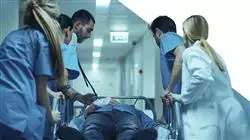University certificate
The world's largest faculty of medicine”
Introduction to the Program
Keeping knowledge up to date is key to providing safe and efficient patient care in critical situations. Specialize with the most advanced program, which includes
the latest developments in coronavirus infections"

Healthcare professionals must be specifically prepared to act in an emergency situation in order to maintain the level of quality and safety in patient care. Adequate updating becomes an indispensable tool to ensure safe and efficient care. They must be prepared to identify and deal with any critical situation they encounter quickly, with full capacity to plan, manage and apply the necessary health resources at the different levels of medical care. This includes patient care processes involving patients with emergency conditions, emergency situations, as well as incidents of special operational difficulty, whether they are the result of an accident with multiple victims, seismic or climatological phenomena, or even war or terrorism.
The medicine applied in emergency situations must also contemplate a wide knowledge of the available means and equipment, their applications and complications, so that they can be used in each specific situation. For this reason, an adequate updating of knowledge requires a comprehensive approach to techniques, procedures and application regulations, a complete and exhaustive training program that becomes an essential tool to identify and deal with any critical situation, especially in circumstances
of special operational difficulty.
This includes disaster situations, where material and human resources become insufficient, infrastructures are severely damaged, and the number and severity of patients generate particularly critical situations. These features call for a specific and in-depth approach to management, organization and health care in adverse circumstances. Catastrophic events in the recent past show the importance of having health professionals with specialized training to be able to provide care in particularly serious circumstances.
This program provides students with the knowledge and skills required to provide emergency health care quickly, efficiently and safely. Tools that will allow you to properly assess emergency patients, to know and apply the appropriate procedures in each situation, or to become familiar with the drugs frequently used in critical situations. All this through the most up-to-date training program, including the latest developments in coronavirus infections.
Access the most comprehensive program to act in critical situations with the Professional master’s degree in Emergency Medicine"
This Professional master’s degree in Emergency Medicine contains the most complete and up-to-date Scientific program on the market. The most important features of the program include:
- Practical cases presented by experts in the field of patient care in accident, emergency and disaster situations
- The graphic, schematic and practical contents with which they are created provide scientific and practical information on the disciplines that are essential for professional practice
- The latest information on patient care in emergency situations
- Practical exercises where self-assessment can be used to improve learning
- With emphasis on innovative methodologies for patient care in accident, emergency and disaster situations
- Theoretical lessons, questions for experts, discussion forums on controversial issues and individual reflection work
- Content that is accessible from any fixed or portable device with an Internet connection
This Professional master’s degree is the best investment you can make when choosing a refresher programme to update your existing knowledge of Emergency Medicine"
Its teaching staff includes professionals from the field of medicine, who their work experience to this program, as well as renowned specialists from leading societies and prestigious universities.
The multimedia content, developed with the latest educational technology, will provide the professional with situated and contextual learning, i.e., a simulated environment that
will provide an immersive training experience designed to train for real-life situations.
This program is designed around Problem-Based Learning, whereby the physician must
try to solve the different professional practice situations that arise throughout
the program. For this purpose, the specialist will be assisted by an innovative interactive video system created by renowned experts in the field of accidents, emergencies and disasters with extensive experience.
We offer you an interactive video system that will make it easier for you to study this Professional master’s degree"

In our Professional master’s degree, you will learn the main problems faced by doctors in emergency situations, including the main developments in the diagnosis and treatment of COVID-19"
Why study at TECH?
TECH is the world’s largest online university. With an impressive catalog of more than 14,000 university programs available in 11 languages, it is positioned as a leader in employability, with a 99% job placement rate. In addition, it relies on an enormous faculty of more than 6,000 professors of the highest international renown.

Study at the world's largest online university and guarantee your professional success. The future starts at TECH”
The world’s best online university according to FORBES
The prestigious Forbes magazine, specialized in business and finance, has highlighted TECH as “the world's best online university” This is what they have recently stated in an article in their digital edition in which they echo the success story of this institution, “thanks to the academic offer it provides, the selection of its teaching staff, and an innovative learning method aimed at educating the professionals of the future”
A revolutionary study method, a cutting-edge faculty and a practical focus: the key to TECH's success.
The most complete study plans on the university scene
TECH offers the most complete study plans on the university scene, with syllabuses that cover fundamental concepts and, at the same time, the main scientific advances in their specific scientific areas. In addition, these programs are continuously being updated to guarantee students the academic vanguard and the most in-demand professional skills. In this way, the university's qualifications provide its graduates with a significant advantage to propel their careers to success.
TECH offers the most comprehensive and intensive study plans on the current university scene.
A world-class teaching staff
TECH's teaching staff is made up of more than 6,000 professors with the highest international recognition. Professors, researchers and top executives of multinational companies, including Isaiah Covington, performance coach of the Boston Celtics; Magda Romanska, principal investigator at Harvard MetaLAB; Ignacio Wistumba, chairman of the department of translational molecular pathology at MD Anderson Cancer Center; and D.W. Pine, creative director of TIME magazine, among others.
Internationally renowned experts, specialized in different branches of Health, Technology, Communication and Business, form part of the TECH faculty.
A unique learning method
TECH is the first university to use Relearning in all its programs. It is the best online learning methodology, accredited with international teaching quality certifications, provided by prestigious educational agencies. In addition, this disruptive educational model is complemented with the “Case Method”, thereby setting up a unique online teaching strategy. Innovative teaching resources are also implemented, including detailed videos, infographics and interactive summaries.
TECH combines Relearning and the Case Method in all its university programs to guarantee excellent theoretical and practical learning, studying whenever and wherever you want.
The world's largest online university
TECH is the world’s largest online university. We are the largest educational institution, with the best and widest online educational catalog, one hundred percent online and covering the vast majority of areas of knowledge. We offer a large selection of our own degrees and accredited online undergraduate and postgraduate degrees. In total, more than 14,000 university degrees, in eleven different languages, make us the largest educational largest in the world.
TECH has the world's most extensive catalog of academic and official programs, available in more than 11 languages.
Google Premier Partner
The American technology giant has awarded TECH the Google Google Premier Partner badge. This award, which is only available to 3% of the world's companies, highlights the efficient, flexible and tailored experience that this university provides to students. The recognition as a Google Premier Partner not only accredits the maximum rigor, performance and investment in TECH's digital infrastructures, but also places this university as one of the world's leading technology companies.
Google has positioned TECH in the top 3% of the world's most important technology companies by awarding it its Google Premier Partner badge.
The official online university of the NBA
TECH is the official online university of the NBA. Thanks to our agreement with the biggest league in basketball, we offer our students exclusive university programs, as well as a wide variety of educational resources focused on the business of the league and other areas of the sports industry. Each program is made up of a uniquely designed syllabus and features exceptional guest hosts: professionals with a distinguished sports background who will offer their expertise on the most relevant topics.
TECH has been selected by the NBA, the world's top basketball league, as its official online university.
The top-rated university by its students
Students have positioned TECH as the world's top-rated university on the main review websites, with a highest rating of 4.9 out of 5, obtained from more than 1,000 reviews. These results consolidate TECH as the benchmark university institution at an international level, reflecting the excellence and positive impact of its educational model.” reflecting the excellence and positive impact of its educational model.”
TECH is the world’s top-rated university by its students.
Leaders in employability
TECH has managed to become the leading university in employability. 99% of its students obtain jobs in the academic field they have studied, within one year of completing any of the university's programs. A similar number achieve immediate career enhancement. All this thanks to a study methodology that bases its effectiveness on the acquisition of practical skills, which are absolutely necessary for professional development.
99% of TECH graduates find a job within a year of completing their studies.
Professional Master's Degree in Emergency Medicine
Patients in serious situations, as a result of circumstances related to terrorism, war conflicts, seismic and climatological phenomena, traffic accidents, among others, require specialized care by health professionals. However, without prior education it is not possible to provide this type of services, so TECH Global University developed a Professional Master's Degree in Emergency. Its purpose is to provide doctors with the tools, skills, abilities and knowledge to respond correctly to situations in which the patient's life may be compromised and different organs affected.
The most up-to-date Professional Master's Degree
Through a syllabus divided into ten content modules, taken over twelve months, students of the Professional Master's Degree in Emergency Medicine at the TECH's Faculty of Medicine will be able to learn about emergency services, medical transport, incidents with multiple victims and even the care of coronavirus infections, among other topics. Therefore, medical professionals will be prepared to differentiate the concepts of emergencies, disasters and catastrophes, describe the main characteristics of medical transport, its pathophysiology and the different transport devices, and prioritize, organize and manage care in a more effective way through triage.







